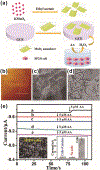Functional nanoarrays for investigating stem cell fate and function
- PMID: 32090229
- PMCID: PMC7671654
- DOI: 10.1039/c9nr10963c
Functional nanoarrays for investigating stem cell fate and function
Abstract
Stem cells show excellent potential in the field of tissue engineering and regenerative medicine based on their excellent capability to not only self-renew but also differentiate into a specialized cell type of interest. However, the lack of a non-destructive monitoring system makes it challenging to identify and characterize differentiated cells before their transplantation without compromising cell viability. Thus, the development of a non-destructive monitoring method for analyzing cell function is highly desired and can significantly benefit stem cell-based therapies. Recently, nanomaterial-based scaffolds (e.g., nanoarrays) have made possible considerable advances in controlling the differentiation of stem cells and characterization of the differentiation status sensitively in real time. This review provides a selective overview of the recent progress in the synthesis methods of nanoarrays and their applications in controlling stem cell fate and monitoring live cell functions electrochemically. We believe that the topics discussed in this review can provide brief and concise guidelines for the development of novel nanoarrays and promote the interest in live cell study applications. A method which can not only control but also monitor stem cell fate and function will be a promising technology that can accelerate stem cell therapies.
Conflict of interest statement
Conflicts of interest
The authors do not have any conflicts of interest to declare.
Figures






References
Publication types
MeSH terms
Grants and funding
LinkOut - more resources
Full Text Sources
Medical

